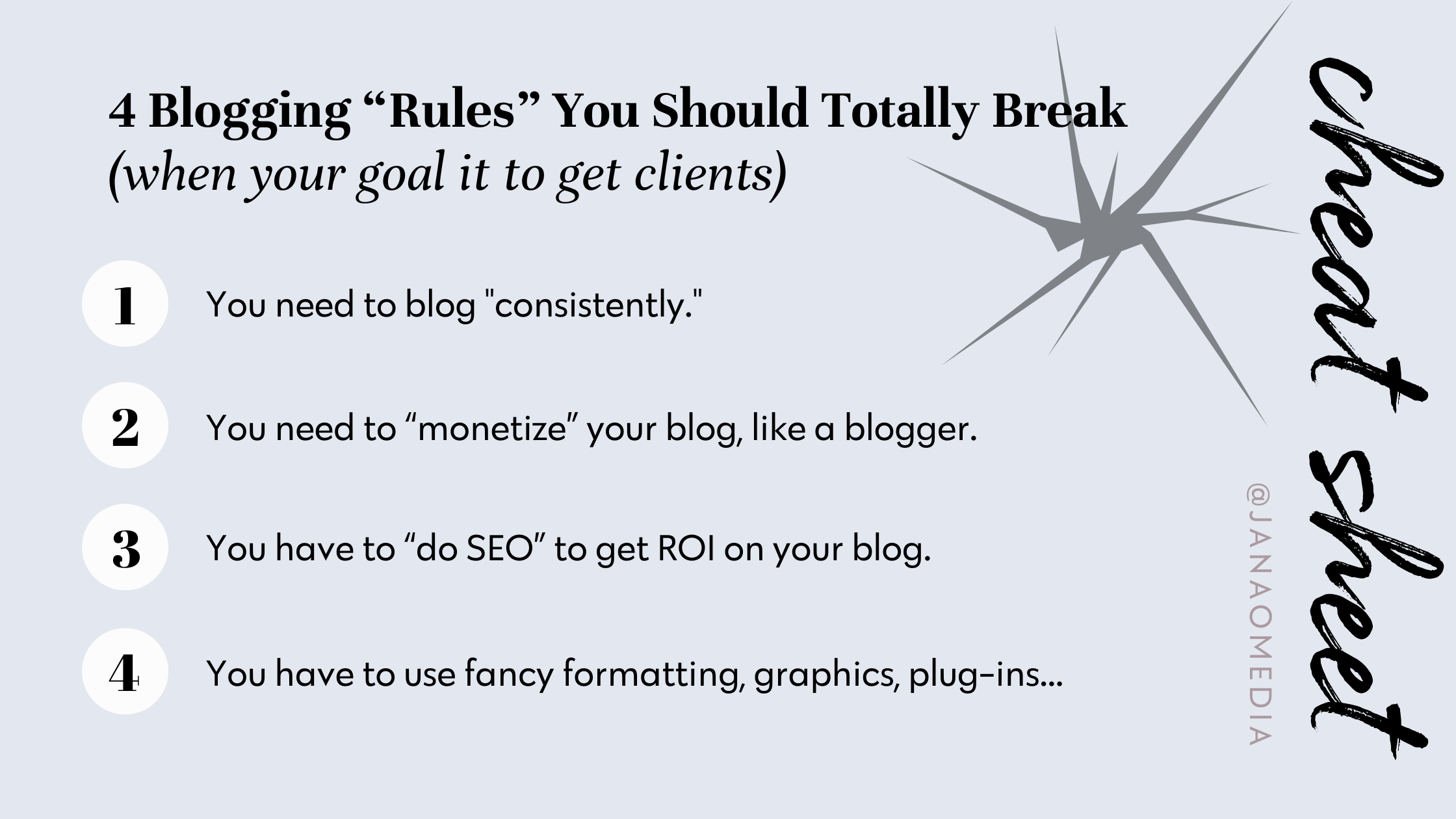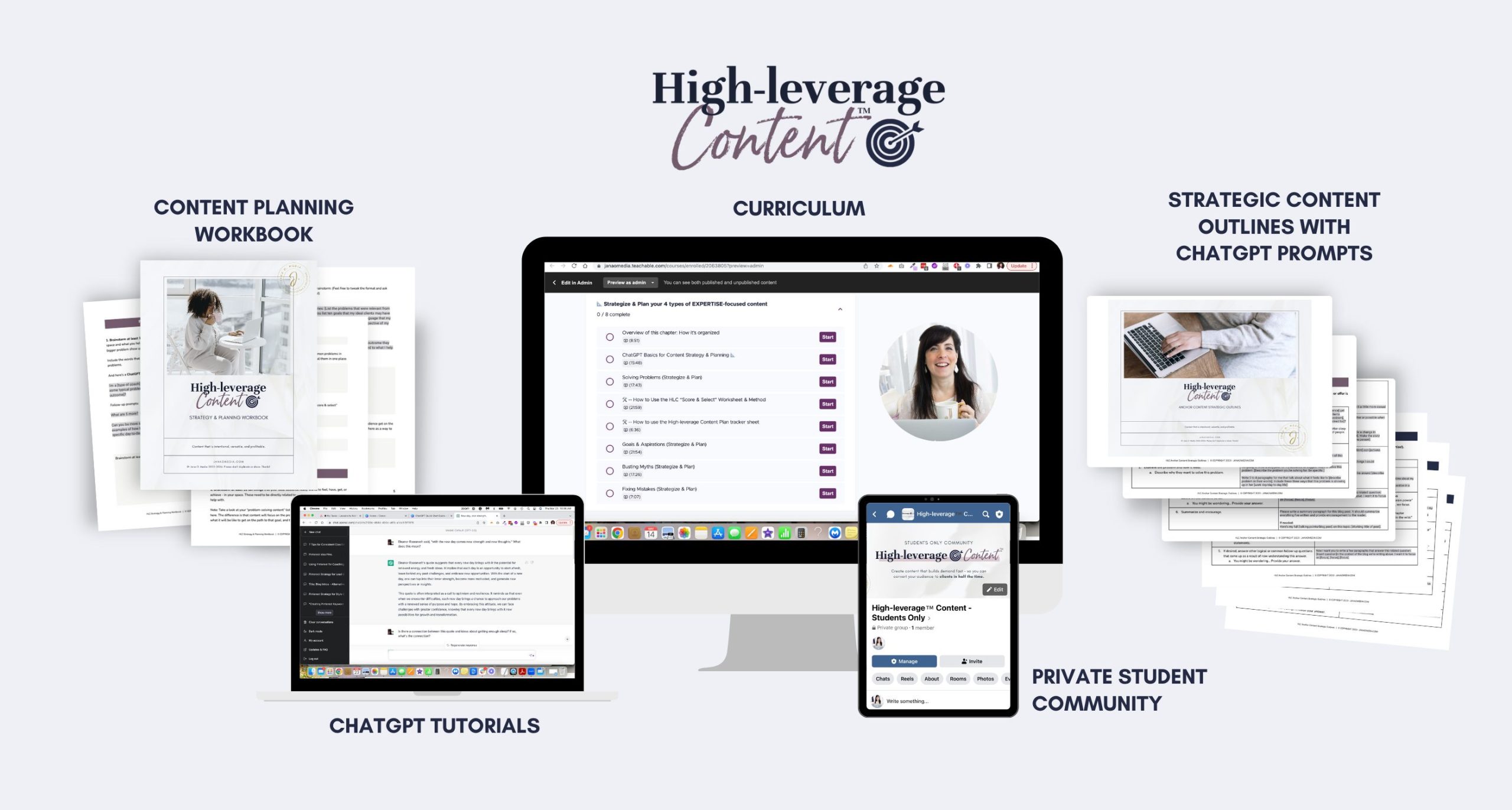You’re ready to ditch the hamster wheel strategies — and trade them in for an evergreen blog that works 24/7 for you to attract and convert clients. But…
You feel overwhelmed by all the different considerations and “rules” that you hear online from the blogging community…
SEO… Plug-ins… Weekly posts… Backlinking… Ugh. 😵💫
But here’s the thing to know:
If you’re a coach or a service provider, so many of the “blogger rules” you hear online actually don’t even apply to you and your blog. 😲
… Because you’re not a blogger. You’re a business owner with a blog.
And there’s a big difference between those two.
Your goals are different, so your priorities and tactics need to be, too…
Which means that trying to follow those rules is not only unnecessary – but it’s keeping you from having a blog that can become your #1 client-roster-builder.
So let’s examine some of these “rules” that you may *think* you have to follow. I’ll tell you which parts you should pay attention to, and which ones you can ignore!
When you understand this, your blog will be so much more “do-able” and easy to write — and it will be so much more high-converting, too.
Ready? Let’s be rule-breakers! 🙂 💥 🤛🏽
❌ RULE 1 to break: You must blog consistently.
Nope. Break it! 💥 🤛🏽
As a coach or service provider, your blog is a tool to serve your business. It’s *not* a hamster wheel that you must keep spinning, to stay relevant.
(That’s “blogger” thinking, and you’re not a blogger.)
What you actually do need is a finite number of blog posts (I say 12 to 20). They need to cover the key things your audience needs to hear, learn, and understand — to be ready to buy your offer.
I call this a “capsule blog.”
We want these posts to be designed to convert — and we also want them to be easy to repurpose…
That way, once you have your capsule blog library written, you can simply repurpose your key, high-converting messages, on repeat — to generate all your other marketing.
This approach will serve you so well as a coach or service provider, because repetition is actually what helps your messages land and drives conversions — NOT constantly firehosing your audience with new content weekly or even monthly.
And, bonus benefit: This approach also sets you up to be able to easily delegate social media or other content repurposing projects to a team member, and get great ROI from that investment…
For example, one of my High-leverage Content students, Naomi, used the tools inside to write 9 strategic blog posts. (She did that in about 60 days, but you can do this on any timeline.) Then she hired a content repurposing VA to take over her LinkedIN. 👏🏼👏🏼👏🏼 So good!
❌ RULE 2 to break: You need to “monetize” your blog.
Quick story: My husband has a good friend, who stays with us a lot. We love having him. He’s a great guest — but there is ONE thing I wish he’d stop doing when he visits…
(Yes, I promise this story will relate to your blog…🤣)
He knows that Heather and I have a weekly Youtube show…
And he always tells me he watches Youtube channels about cars or the stock market or travel or whatever… And he tells me that those content creators make SO MUCH MONEY by “monetizing their channel’ (meaning Youtube pays them based on views).
So that is what I should be doing to make money, according to him — monetizing with views. 🤭
I gracefully remind him that I have a *totally different business model* as a coach and course creator… and that Heather and I both make SO MUCH MONEY by growing our audiences on Youtube and selling our coaching programs to those audiences…
But alas. Next visit, he still wants me to become Youtube famous. 🤣
One of these days he’ll get it… Or not. 🤷🏻♀️
Anyway, all this to say… The same thing applies to your blog. You don’t need to “monetize it” like a blogger does.
So if you thought that was a rule for your blog… Break it! 💥 🤛🏽
The way you make money with a blog, as a coach or service provider, is to write blog posts that attract and convert clients.
You don’t need to apply to be part of an ad network to get paid that way. You don’t have to add a bunch of Amazon affiliate links to your posts (only to make $1.29 twice a month when someone buys the thing. 🙄)
You want your blog to help sell your coaching or services — so (again,) your focus will be a small-but-mighty library of blog posts that cover the things people need from you, to be ready to buy.
(PS – Don’t mis-read my eye roll above. There’s nothing inherently wrong with the “blogger” business model of ads and affiliate links [or with the Youtube for views model, either!] — but it’s just totally different than your goal, which is to get clients… So don’t get distracted or divide your attention.)
(Rule #3 to break 💥 is up next… But first, here’s a quick cheat sheet for you to save:)

❌ RULE 3 to break: You need to do SEO when you start your blog.
This rule can be particularly hard to shake, but if you want to start a blog that will get you clients, you need to… Break it! 💥 🤛🏽
You do NOT need to know how to “do SEO” when you start your blog.
I’m going to share a secret with you here…
Every single coach or service provider that I know, who now gets found on Google, did NOT start with writing around SEO keywords. 🤯 They just started by writing about what their audience needs, and *over time* they began to rank on Google.
Meanwhile, it never fails… Whenever I see a coach or service provider start a blog by trying to “do SEO,” they inevitably get stuck and don’t follow through. (THIS IS NORMAL, so it it’s happened to you — you’re not the only one!)
Waiting until you understand technical SEO…
Thinking you have to write “Comprehensive Guides” that give it all away for free…
Trying to write around keywords (ugh! So NOT good for creativity!)…
👆🏻These things will keep you stuck — and keep you from having a blog that gets you clients.
So here’s what you do instead, as a coach or service provider:
For your first 12 blog posts, simply focus on the things your audience needs to hear, learn, and understand more deeply, to be ready to BUY. <<< This is the most realistic, most sustainable, and most profitable way to start a blog that will get you clients.
This is how I started. This is how everyone I know (who didn’t quit with a few half-written posts in their Google docs) started.
This is how my High-leverage Content students start, too, of course — because that’s how I teach them to do it!.
Here’s what one of them, Patricia (a doula and sleep coach) said about this approach recently, in our student Facebook group:
“I did this like Jana recommends – I wrote a bunch of blogs that sounded right to me… and then this past year, it finally clicked: [I saw how] how the search terms that brought people to my website were matching with my blog posts, and I have revised my most popular posts (that were already bringing good traffic) to dial in the messaging and optimize headers etc.
But if I had worried about all that when I was just getting started, it would’ve slowed me down so much. So, just write for now!”
This “SEO thing” is a nuanced topic, and I wrote more extensively about it in this blog post, if you want to dig deeper.
But trust me, don’t worry for a minute about SEO when you get started. It will only be a barrier to your progress at this stage.
Now, lastly…
❌ RULE 4 to break: You need a bunch of fancy formatting, graphics, plug-ins — for your blog to give you ROI.
Also doesn’t apply – mostly. So… Break it! 💥 🤛🏽
(And I’ll explain the “mostly” part…)
You don’t need a blog that looks like it was designed by a tech wizard, a Pinterest girlie, or a food blogger.
In fact, with the strategies I teach, simpler is better… Because when you’re focusing on conversion, what matters most is your content — the words you write and how they resonate with your audience.
In other words, fancy formatting doesn’t create trust or authority; your insights do.
You just need a simple blog, and setting that up is easier than you might think.
One of my High-leverage Content students, Mary, is a great example of how simple it can be…
She used the HLC system to write two powerful blog posts — and was so proud of them. But then she panicked… because she had no idea how to actually publish them on her blog. She even asked if she could just link to her Google Docs 🤯.
I got her sorted with a simple, clean blog setup (no bells, whistles, or widgets required), and within 60 days, those two blog posts brought in two new clients. (Good thing she didn’t over-complicate things and never write or post!)
Now…
The only formatting “rules” that I say do apply here are:
You do want a clean design and easy-to-read format. So, for example, if your blog has a background and font that are similar in color, and that makes it hard to read, I’ll tell you to fix that.
You don’t want “walls of text.” Because people will skim first and decide to read based on that skim. Long paragraphs with few line breaks don’t feel that way… So, I’ll have you break up your paragraphs in very logical places. This is really as simple as hitting return where it makes sense.
But other than that, you don’t need any fancy graphics, Header 3’s, or the like.
When you focus on writing what your audience needs to learn, hear, and understand more deeply, to be ready to buy… Your words alone will convert.
✅ Summary + What you *do* need, to get ROI from your blog.
Okay, so… In this post, we’ve established this:
As a coach or service provider — someone who wants your blog to serve as a versatile, evergreen content bank that converts your people to clients (fast!) — you don’t need a consistent posting schedule, an SEO plan, affiliate links, or fancy formatting… (Who knew?? 😲)
So don’t let any of those “rules” slow you down (or keep you from starting).
But…
You DO need:
- To get clear on what your audience needs, to be ready to buy.
- A way to structure those posts so they are high-converting.
- A system to write those posts quickly.
Inside my signature program, High-leverage Content (HLC), I show you exactly how to achieve these key things.
We use a ‘9-in-2 Content Pillars’ system, and a comprehensive topic selection process, to be sure we’re choosing topics based on what your audience needs, to ready to buy.
I give you 9 comprehensive, foolproof ‘Strategic Content Outlines,’ too. These walk you, line-by-line, paragraph-by-paragraph, what to write in your blog posts, to make them super-compelling to your future clients — and high-converting.
(And these are just a couple of the tools and frameworks you’ll get inside HLC!)
You’ll be able to use the system to create a library of 12 blog posts that will convert your audience to clients, and will be easy to repurpose on repeat!
Want to learn more? Click the button below 👇🏼 to get the details and sign up!



